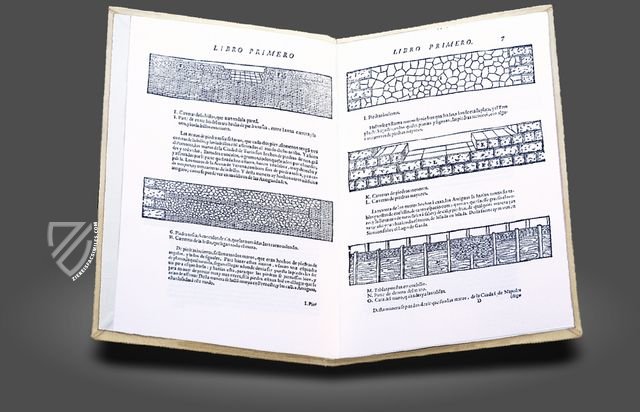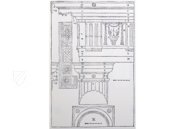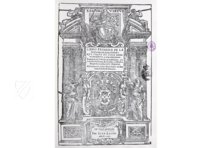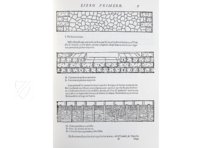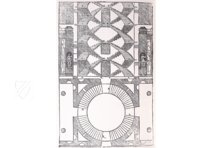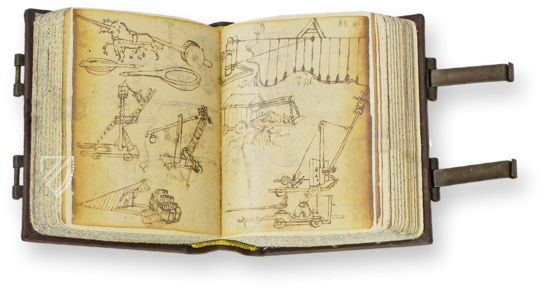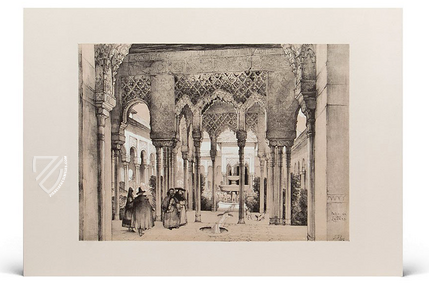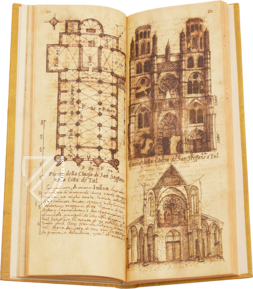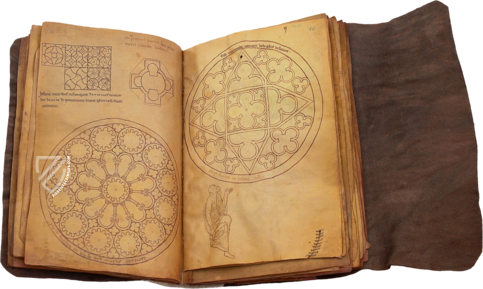First Book of Architecture by Andrea Palladio
(under 1,000€)
Andrea Palladio was the first professional architect of the Italian Renaissance and the most significant architectural theorist of the Middle Ages. His construction projects and writings influenced architects across the entire world and he had not lost any of his fame today. Some of his buildings have served as film backdrops over the last decades, e.g. in the film Casanova by Lasse Halström. The text at hand is the first part of his four-volume treatise on architecture from the year 1570, the Quattro libri. The edition was translated into Spanish in 1625 and features numerous printed graphics that are sharply and precisely engraved.
First Book of Architecture by Andrea Palladio
Alongside Leon Battista Alberti, the edifices and the so-called Quattro libri by the Italian Andrea Palladio make him the most influential master builder and architectural theorist of the early modern era. Its four volumes comprise a series of publications about architecture and has been frequently translated and now exists in every world language. After its 1715 translation into English by the architect Giacomo Leoni, Palladio’s work influenced the protestant and Anglican architecture of northern Europe above all. It concerns itself with inter alia building materials, foundations, ordering of columns, floors, and doors. This is a Spanish edition from 1625, which was translated by Francisco di Praves and printed in the workshop of Juan Lasso. The text is furnished with countless detailed and sharply engraved print graphics, illustrating what is explained.
Architecture in Theory and Practice
The master builder Andrea Palladio left behind a comprehensive architectural work, which is the topic of intense discussion today. Every year, thousands of art enthusiasts make the pilgrimage to his villas, most of which were built in Venice. The so-called Palladian architecture is spread across the entire world today. His fame is grounded, however, in his own construction activity and four books on architecture that came to be a reflection on fundamental architectural questions. In the first book, Palladio discusses all of the basic elements to be observed by the construction of a building. The second book is devoted to the construction of private homes in the city and in the country. Public secular buildings and the art of urban architecture are themes of the third book. The fourth and most comprehensive book finally concerns itself with sacred buildings of antiquity.
The First Architect of the Renaissance
Andrea di Piero della Gondola, Palladio’s actual name, was arguably the most important architect of Upper Italy during the Renaissance. Palladio was the first “pure” architect in the history of medieval architecture, whose fame reached beyond the borders of Italy. He concerned himself exclusively with the construction of edifices and was active in no other artistic field. His role models were Roman antiquity and the great architecture of the Italian Renaissance, above all Bramante, Michelangelo, Sanmicheli, and Sanosovino. Their construction projects were never pedantically imitated by him, but rather were continuously transformed creatively and unconventionally for the respective building assignment. Palladio’s architectural style demonstrated a unique harmony and elegance in all of his edifices. He won great influence as the founder of Palladian architecture through his buildings and his theoretical writings. He was considered to be an example for the classically-indebted architects of Western and Northern Europe, Great Britain, and the United States.
Codicology
- Alternative Titles
- Libro primero de la architectura de Andrea Palladio
Erstes Buch der Architektur von Andrea Palladio - Size / Format
- 96 pages / 31.8 × 21.5 cm
- Origin
- Spain
- Date
- 1625
- Epochs
- Style
- Language
- Illustrations
- Many engravings of architectural structures, parts and other motives
Architectural frontispiece with coat of arms - Content
- Treatise on architecture
- Artist / School
- Andrea Palladio (author)
Francisco de Praves (translator)
Juan Lasso (printer)
First Book of Architecture by Andrea Palladio
Frontispiece
This extremely detailed, classically styled engraving appropriately presents the title of the first book flanked by Corinthian columns in a temple-like structure, upon which heralds are seated and blowing trumpets to proclaim the publication of this important architectural treatise. Labelled as REGINA VIRTVS, the Queen of Virtue is shown enthroned, crowned, and holding a scepter while dressed in flowing robes. She is reading from a codex, presumably the work at hand.

First Book of Architecture by Andrea Palladio
The Doric Order
Aside from discussing various building materials and techniques, the first book of Palladio’s architectural treatise also describes the five classical orders. Palladio illustrates the Doric Order here using simple, clean lines and includes various details such as common decorative elements like small flowers, a lion’s head, and the large bull’s skull on the entablature.
Originating from western Greece and the mainland, the Doric is the simplest of the classical orders with simple capitals and no base. It is also the heaviest with respect to the proportions of its columns, which feature 16 flutes. The entablature is divided into a smooth or horizontally-grooved lower half, and an upper half that alternates between triglyphs and metopes.
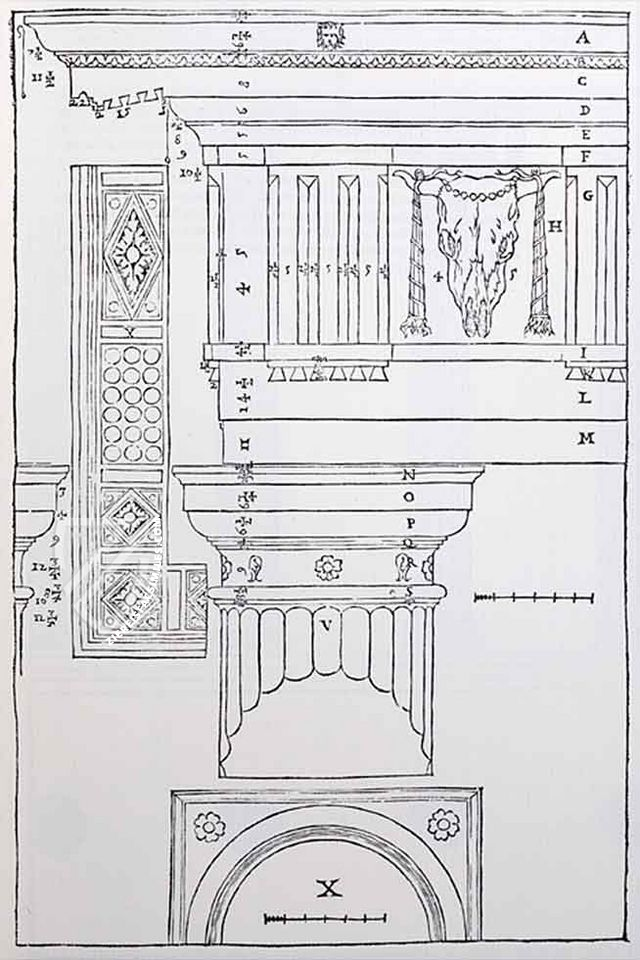
#1 Libro primero de la architectura de Andrea Palladio
Language: Spanish
(under 1,000€)
- Treatises / Secular Books
- Apocalypses / Beatus
- Astronomy / Astrology
- Bestiaries
- Bibles / Gospels
- Chronicles / History / Law
- Geography / Maps
- Saints' Lives
- Islam / Oriental
- Judaism / Hebrew
- Single Leaf Collections
- Leonardo da Vinci
- Literature / Poetry
- Liturgical Manuscripts
- Medicine / Botany / Alchemy
- Music
- Mythology / Prophecies
- Psalters
- Other Religious Books
- Games / Hunting
- Private Devotion Books
- Other Genres
- Afghanistan
- Armenia
- Austria
- Belgium
- Belize
- Bosnia and Herzegovina
- China
- Colombia
- Costa Rica
- Croatia
- Cyprus
- Czech Republic
- Denmark
- Egypt
- El Salvador
- Ethiopia
- France
- Germany
- Greece
- Guatemala
- Honduras
- Hungary
- India
- Iran
- Iraq
- Israel
- Italy
- Japan
- Jordan
- Kazakhstan
- Kyrgyzstan
- Lebanon
- Liechtenstein
- Luxembourg
- Mexico
- Morocco
- Netherlands
- Palestine
- Panama
- Peru
- Poland
- Portugal
- Romania
- Russia
- Serbia
- Spain
- Sri Lanka
- Sweden
- Switzerland
- Syria
- Tajikistan
- Turkey
- Turkmenistan
- Ukraine
- United Kingdom
- United States
- Uzbekistan
- Vatican City
- A. Oosthoek, van Holkema & Warendorf
- Aboca Museum
- Ajuntament de Valencia
- Akademie Verlag
- Akademische Druck- u. Verlagsanstalt (ADEVA)
- Aldo Ausilio Editore - Bottega d’Erasmo
- Alecto Historical Editions
- Alkuin Verlag
- Almqvist & Wiksell
- Amilcare Pizzi
- Andreas & Andreas Verlagsbuchhandlung
- Archa 90
- Archiv Verlag
- Archivi Edizioni
- Arnold Verlag
- ARS
- Ars Magna
- ArtCodex
- AyN Ediciones
- Azimuth Editions
- Badenia Verlag
- Bärenreiter-Verlag
- Belser Verlag
- Belser Verlag / WK Wertkontor
- Benziger Verlag
- Bernardinum Wydawnictwo
- BiblioGemma
- Biblioteca Apostolica Vaticana (Vaticanstadt, Vaticanstadt)
- Bibliotheca Palatina Faksimile Verlag
- Bibliotheca Rara
- Boydell & Brewer
- Bramante Edizioni
- Bredius Genootschap
- Brepols Publishers
- British Library
- C. Weckesser
- Caixa Catalunya
- Canesi
- CAPSA, Ars Scriptoria
- Caratzas Brothers, Publishers
- Carus Verlag
- Casamassima Libri
- Centrum Cartographie Verlag GmbH
- Chavane Verlag
- Christian Brandstätter Verlag
- Circulo Cientifico
- Club Bibliófilo Versol
- Club du Livre
- CM Editores
- Collegium Graphicum
- Collezione Apocrifa Da Vinci
- Comissão Nacional para as Comemorações dos Descobrimentos Portugueses
- Coron Verlag
- Corvina
- CTHS
- D. S. Brewer
- Damon
- De Agostini/UTET
- De Nederlandsche Boekhandel
- De Schutter
- Deuschle & Stemmle
- Deutscher Verlag für Kunstwissenschaft
- DIAMM
- Droz
- E. Schreiber Graphische Kunstanstalten
- Ediciones Boreal
- Ediciones Grial
- Ediclube
- Edições Inapa
- Edilan
- Editalia
- Edition Deuschle
- Edition Georg Popp
- Edition Leipzig
- Edition Libri Illustri
- Editiones Reales Sitios S. L.
- Éditions de l'Oiseau Lyre
- Editions Medicina Rara
- Editorial Casariego
- Editorial Mintzoa
- Editrice Antenore
- Editrice Velar
- Edizioni Edison
- Egeria, S.L.
- Eikon Editores
- Electa
- Emery Walker Limited
- Enciclopèdia Catalana
- Eos-Verlag
- Ephesus Publishing
- Ernst Battenberg
- Eugrammia Press
- Extraordinary Editions
- Fackelverlag
- Facsimila Art & Edition
- Facsimile Editions Ltd.
- Facsimilia Art & Edition Ebert KG
- Faksimile Verlag
- Feuermann Verlag
- Folger Shakespeare Library
- Franco Cosimo Panini Editore
- Friedrich Wittig Verlag
- Fundación Hullera Vasco-Leonesa
- G. Braziller
- Gabriele Mazzotta Editore
- Gebr. Mann Verlag
- Gesellschaft für graphische Industrie
- Getty Research Institute
- Giovanni Domenico de Rossi
- Giunti Editore
- Graffiti
- Grafica European Center of Fine Arts
- Guido Pressler
- Guillermo Blazquez
- Gustav Kiepenheuer
- H. N. Abrams
- Harrassowitz
- Harvard University Press
- Helikon
- Hendrickson Publishers
- Henning Oppermann
- Herder Verlag
- Hes & De Graaf Publishers
- Hoepli
- Holbein-Verlag
- Houghton Library
- Hugo Schmidt Verlag
- Idion Verlag
- Il Bulino, edizioni d'arte
- ILte
- Imago
- Insel Verlag
- Instituto de Estudios Altoaragoneses
- Instituto Nacional de Antropología e Historia
- Istituto dell'Enciclopedia Italiana - Treccani
- Istituto Ellenico di Studi Bizantini e Postbizantini
- Istituto Geografico De Agostini
- Istituto Poligrafico e Zecca dello Stato
- Italarte Art Establishments
- Jan Thorbecke Verlag
- Johnson Reprint Corporation
- Josef Stocker
- Josef Stocker-Schmid
- Jugoslavija
- Karl W. Hiersemann
- Kasper Straube
- Kaydeda Ediciones
- Kindler Verlag / Coron Verlag
- Kodansha International Ltd.
- Konrad Kölbl Verlag
- Kurt Wolff Verlag
- La Liberia dello Stato
- La Linea Editrice
- La Meta Editore
- Lambert Schneider
- Landeskreditbank Baden-Württemberg
- Leo S. Olschki
- Les Incunables
- Liber Artis
- Library of Congress
- Libreria Musicale Italiana
- Lichtdruck
- Lito Immagine Editore
- Lumen Artis
- Lund Humphries
- M. Moleiro Editor
- Maison des Sciences de l'homme et de la société de Poitiers
- Manuscriptum
- Martinus Nijhoff
- Maruzen-Yushodo Co. Ltd.
- MASA
- Massada Publishers
- McGraw-Hill
- Metropolitan Museum of Art
- Militos
- Millennium Liber
- Müller & Schindler
- Nahar - Stavit
- Nahar and Steimatzky
- National Library of Wales
- Neri Pozza
- Nova Charta
- Oceanum Verlag
- Odeon
- Orbis Mediaevalis
- Orbis Pictus
- Österreichische Staatsdruckerei
- Oxford University Press
- Pageant Books
- Parzellers Buchverlag
- Patrimonio Ediciones
- Pattloch Verlag
- PIAF
- Pieper Verlag
- Plon-Nourrit et cie
- Prestel Verlag
- Princeton University Press
- Prisma Verlag
- Priuli & Verlucca, editori
- Pro Sport Verlag
- Propyläen Verlag
- Pytheas Books
- Quaternio Verlag Luzern
- Reales Sitios
- Recht-Verlag
- Reichert Verlag
- Reichsdruckerei
- Reprint Verlag
- Riehn & Reusch
- Roberto Vattori Editore
- Rosenkilde and Bagger
- Roxburghe Club
- Salerno Editrice
- Saltellus Press
- Sandoz
- Sarajevo Svjetlost
- Schöck ArtPrint Kft.
- Schulsinger Brothers
- Scolar Press
- Scrinium
- Scripta Maneant
- Scriptorium
- Shazar
- Siloé, arte y bibliofilia
- SISMEL - Edizioni del Galluzzo
- Sociedad Mexicana de Antropología
- Société des Bibliophiles & Iconophiles de Belgique
- Soncin Publishing
- Sorli Ediciones
- Stainer and Bell
- Studer
- Styria Verlag
- Sumptibus Pragopress
- Szegedi Tudomànyegyetem
- Taberna Libraria
- Tarshish Books
- Taschen
- Tempus Libri
- Testimonio Compañía Editorial
- Thames and Hudson
- The Clear Vue Publishing Partnership Limited
- The Facsimile Codex
- The Folio Society
- The Marquess of Normanby
- The Richard III and Yorkist History Trust
- Tip.Le.Co
- TouchArt
- TREC Publishing House
- TRI Publishing Co.
- Trident Editore
- Typis Regiae Officinae Polygraphicae
- Union Verlag Berlin
- Universidad de Granada
- University of California Press
- University of Chicago Press
- Urs Graf
- Vallecchi
- Van Wijnen
- VCH, Acta Humaniora
- VDI Verlag
- VEB Deutscher Verlag für Musik
- Verlag Anton Pustet / Andreas Verlag
- Verlag Bibliophile Drucke Josef Stocker
- Verlag der Münchner Drucke
- Verlag für Regionalgeschichte
- Verlag Styria
- Vicent Garcia Editores
- W. Turnowski Ltd.
- W. Turnowsky
- Waanders Printers
- Wiener Mechitharisten-Congregation (Wien, Österreich)
- Wissenschaftliche Buchgesellschaft
- Wissenschaftliche Verlagsgesellschaft
- Wydawnictwo Dolnoslaskie
- Xuntanza Editorial
- Zakład Narodowy
- Zollikofer AG

